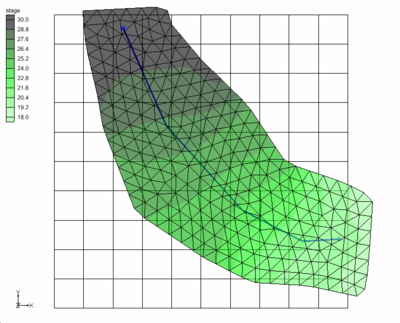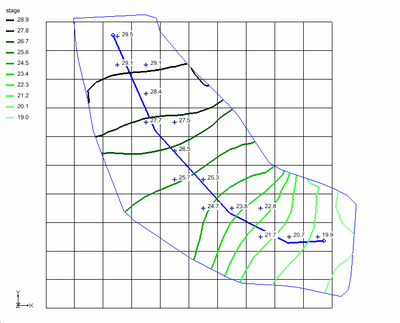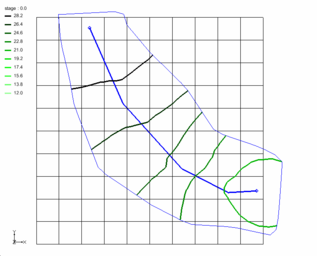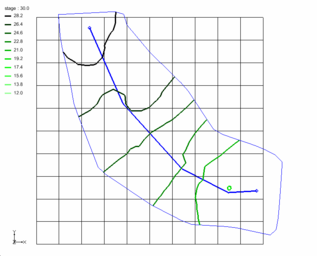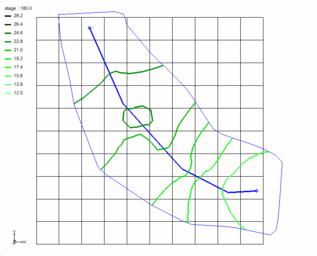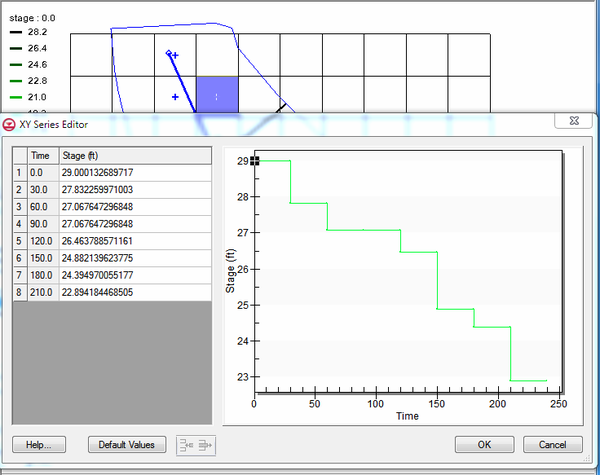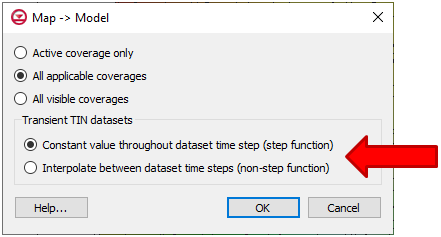GMS:Map to MODFLOW with TINs: Difference between revisions
From XMS Wiki
Jump to navigationJump to search
No edit summary |
No edit summary |
||
| (9 intermediate revisions by the same user not shown) | |||
| Line 2: | Line 2: | ||
At times, instead of assigning values at the upstream and downstream ends of the arc, it is useful to assign a property using a surface. This can be done in GMS using a TIN. | At times, instead of assigning values at the upstream and downstream ends of the arc, it is useful to assign a property using a surface. This can be done in GMS using a TIN. | ||
[[Image:TinModflow1.png|400px|TIN assigned to river stage.]] | :[[Image:TinModflow1.png|400px|TIN assigned to river stage.]] | ||
When the arc is discretized onto the model grid, the cells that intersect the arc are found. Then the boundary condition property is interpolated from the TIN to the cell centers. | When the arc is [[GMS:Temporal Discretization|discretized]] onto the model grid, the cells that intersect the arc are found. Then the boundary condition property is interpolated from the TIN to the cell centers. | ||
[[Image:TinModflow2.png|400px|TIN assigned to river stage.]] | :[[Image:TinModflow2.png|400px|TIN assigned to river stage.]] | ||
Beginning with version 9.1, it is also possible to assign TINs with transient datasets. This gives the option to have a surface that changes with time assigned to a boundary condition property. The times associated with the TIN dataset can be in date/time format or relative time format. | Beginning with version 9.1, it is also possible to assign TINs with transient datasets. This gives the option to have a surface that changes with time assigned to a boundary condition property. The times associated with the TIN dataset can be in date/time format or relative time format. | ||
<gallery widths="320px" heights="256px"> | |||
Image:TinModflow3.png | |||
Image:TinModflow4.png | |||
Image:TinModflow5.png | |||
</gallery> | |||
[[Image:TinModflow6.png|600px|Transient TIN assigned to river stage.]] | :[[Image:TinModflow6.png|600px|Transient TIN assigned to river stage.]] | ||
There is a user preference for treating the transient data on the TIN as a step function or as a continuous curve. This option is selected when performing the Map→MODFLOW operation under the Transient TIN datasets section. | There is a user preference for treating the transient data on the TIN as a step function or as a continuous curve. This option is selected when performing the '''Map→MODFLOW''' operation under the ''Transient TIN datasets'' section. | ||
[[Image:TinModflow7.png|User preference for transient TIN | :[[Image:TinModflow7.png|User preference for transient TIN datasets.]] | ||
| Line 27: | Line 27: | ||
[[Category:TINs]] | [[Category:TINs]] | ||
[[Category:TIN Dialogs]] | [[Category:TIN Dialogs]] | ||
[[Category:GMS Map]] | |||
[[Category:MODFLOW|map]] | |||
{{stub}} | |||
<!--It is unclear how to do the suggested procedure--> | |||
